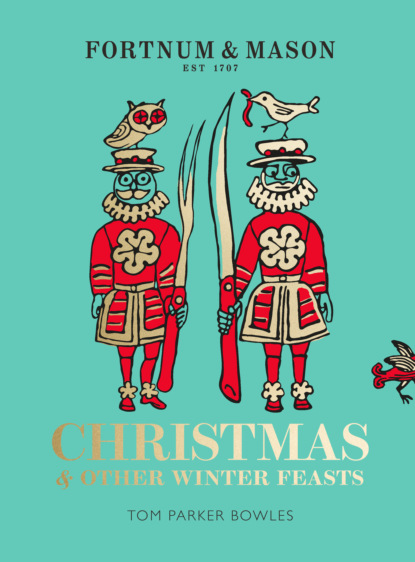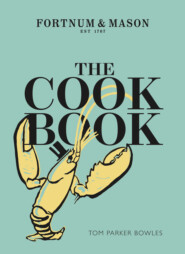По всем вопросам обращайтесь на: info@litportal.ru
(©) 2003-2024.
✖
Fortnum & Mason: Christmas & Other Winter Feasts
Настройки чтения
Размер шрифта
Высота строк
Поля
SERVES 4
· 4 teaspoons rose harissa paste
· 1 teaspoon ras el hanout
· 35ml olive oil
· 4 duck breasts, skin scored 3 or 4 times with a sharp knife
FOR THE SAMOSAS AND SAUCE
· 1 tablespoon sunflower oil
· 2 duck legs
· 1 small carrot, diced
· 1 stick of celery, diced
· 1 small onion, diced
· 1 garlic clove, chopped
· 1 teaspoon ras el hanout
· ½ teaspoon coriander seeds
· 70ml Madeira
· 700ml good-quality chicken stock
· a sprig of thyme
· 3 spring onions, sliced
· 3 tablespoons chopped coriander
· 4 sheets of feuille de brick pastry
· 1 egg, lightly beaten
· sunflower oil, for deep-frying
FOR THE COUSCOUS
· 400ml chicken stock
· a small pinch of saffron strands
· 320g couscous (or mograbia/giant couscous)
· 50g golden raisins (or sultanas)
· 35g flaked almonds, lightly toasted in a dry frying pan
· 3 teaspoons chopped coriander
· Tenderstem broccoli, to serve
Mix the harissa paste, ras el hanout and olive oil together. Put the duck breasts into a shallow dish, rub the mixture all over them, then cover and leave to marinate for at least 6 hours or overnight.
Heat the sunflower oil in a small, heavy-based casserole into which the duck legs fit neatly. Season the legs, then put them into the pan and fry over a medium heat until golden brown all over. Remove from the pan and set aside. Add the diced vegetables, garlic, ras el hanout and coriander seeds to the pan and cook until lightly coloured. Pour in the Madeira and let it bubble until reduced by about two-thirds, stirring to deglaze the base of the pan. Add the stock and bring to a simmer. Return the duck legs to the pan with the thyme, ensuring the legs are submerged in the stock. Bring back to a simmer, then cover the casserole and transfer to an oven heated to 150°C/Gas Mark 2. Cook for 1½–2 hours, until the meat is very tender and comes away from the bone easily. Remove the duck legs from the liquid and leave to cool. Reserve the liquid.
Flake the duck meat into a bowl, discarding the skin and bones, and mix in the spring onions and coriander. Strain the cooking liquor through a fine sieve into a clean pan and simmer until it has a slightly syrupy, sauce-like consistency. Stir about 4 tablespoons of this reduced liquor into the duck mixture; it should be enough to bind it lightly together. Press this mixture into a small baking tray lined with baking parchment so that it forms a layer about 1.5cm thick. Cover with a piece of baking parchment and chill thoroughly. Set aside the rest of the sauce.
To make the samosas, cut the duck leg mixture into 4 triangles. Brush each sheet of feuille de brick with beaten egg, put a triangle of filling on top and fold up into a parcel, making sure you have at least a double thickness of brick pastry around the filling. Brush the edges with more beaten egg to seal. Pour 4cm of sunflower oil into a deep, heavy-based pan and heat it to 170°C. Fry the samosas for about 2 minutes, until golden, flipping them over halfway through. Drain on kitchen paper and set aside.
To prepare the couscous, bring the chicken stock to the boil. Mix the saffron with a tablespoon of the hot stock, then add it to the rest of the stock and stir well. Put the couscous and golden raisins into a bowl. Return the stock to the boil and pour it over the couscous. Cover the bowl tightly with cling film and leave for 5 minutes, then fluff up the couscous gently with a fork. Stir in the flaked almonds and coriander and season well with salt and pepper.
To cook the duck breasts, put a large, heavy-based frying pan over a medium heat. When it is hot, remove the duck breasts from their marinade and place them, skin side down, in the pan. Cook until the skin is golden brown, then turn the breasts over and cook for a minute longer. Transfer the pan to an oven heated to 180°C/Gas Mark 4 and cook for about 8 minutes; the duck meat should still be pink in the centre.
Leave the duck breasts to rest for 5 minutes, then cut each one lengthways in half at an angle. Divide the couscous between 4 serving plates, place the duck on top and add a samosa to each plate. Heat the remaining sauce and pour it around. Serve with Tenderstem broccoli.
Christmas essentials
The list here is a sort of Christmas survival guide, an exhaustive collection of everything you need to have on hand to deal with those last-minute drop-ins. Or late-night hunger pangs. Or mid-afternoon snacks. It takes in the obvious (Champagne, coffee, wine, cheese, mince pies, brandy butter), through to the more exotic (glacé fruits, marrons glacés, Elvas plums and pruneaux d’Agen), and right up to the lavishly lovely (caviar). Christmas has never tasted so good.
BISCUITS TO GO WITH CHEESE
I hardly need to explain this one. But if you’re insisting on the finest cheese (which you are, naturally), find biscuits to match. Fortnum’s has a range to suit every cheese, but I’m also a fan of the Highgrove oat biscuits, and of the classic water biscuits.
BRANDY BUTTER
For me, brandy butter is easily the best thing about Christmas pudding, and makes it just about bearable. In fact, I could eat it straight from the jar. But it’s a Yuletide essential, and just as good melted over mince pies, crumble and other classic puddings.
CAVIAR AND (FRESH) BLINIS
OK, so caviar is not exactly cheap. But then this is Christmas, the time to splash out on the things you really love. And that includes the divine eggs of the sturgeon. It’s now illegal to sell wild caviar in this country, but the farmed stuff is so good these days that even the great experts would be pushed to tell the difference. Beluga is the most expensive variety, as it’s the rarest, and has the biggest eggs. Gunmetal grey in colour, it has a subtle, slightly creamy taste with the merest hint of walnut. My favourite is Oscietra, with smaller eggs but a more pronounced nutty taste, whereas Sevruga has a distinct tang of the sea.
Caviar is best eaten with a non-reactive spoon, as metal tends to give an unpleasant tang. So go for spoons made of horn, mother-of-pearl, or even plastic. If you must. Caviar works beautifully with eggs of any kind (scrambled, boiled, even fried), and with smoked fish, too. I like it piled high on a homemade blini (you can buy decent shop-bought versions, too, which keep well, and are also good with smoked salmon and soured cream) or fresh Melba toast. Some folk like to sully their caviar with chopped egg and onions. Sacrilege! Although each to their own, I suppose. For me, though, caviar needs nothing more than the merest drizzle of lemon. When you’re eating something this rare and exquisite, you want to keep it blessedly simple.
CHAMPAGNE
There is, of course, a Champagne for every mood and moment, from the elegantly light Blanc de Blancs to the rather more nutty, rich and complex Fortnum’s Vintage, made by the great Louis Roederer. And there should always be a couple of bottles sitting chilled in the fridge, ready for any eventuality or hospitality emergency. See it as Christmas First Aid.
CHEESE WITH MULLED WINE JELLY
Another addictive addition to your groaning cheeseboard, this Christmas spiced wine jelly confection works wonders with anything it touches. Add a little to your gravy, for sweet, subtle depth.






